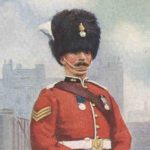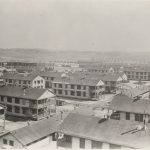The estate of the late John Sayen has graciously allowed the Tactical Notebook to serialize his study of the organizational evolution of American infantry battalions. Other parts of this book can be found with the aid of the guides appended to this post.
On 29 October 1943, a change to the tables of organization of 15 July 1943 provided each infantry regiment with an “athletics and recreation officer.” Ranking as a first lieutenant, this officer served, alongside the other three assistants to the regimental S-1, in the staff section of the service company. (Strange to say, while his assistants could be found on the rolls of the service company, the captain who filled the billet of regimental S-1 officer belonged to the regimental headquarters.)
On 26 February 1944, the War Department promulgated new editions of the tables of organization for infantry regiments that had been approved the previous summer. While these versions of the existing establishments made no changes to the number of men assigned to infantry regiments, they did change the ranks to which many of them could be promoted.

Most of those promoted by the new tables were the leaders of combatant squads. Not all squad leaders, however, received an extra stripe. Thus, the sergeants in charge of the reconnaissance squads of the intelligence and reconnaissance (I&R) platoons remained as they had been.
In cases where the squad leaders of a given platoon rose in rank, the platoon sergeants followed suit. Thus, a number of staff sergeants became technical sergeants. Likewise, the assistant squad leaders of rifle companies, who had been corporals, became sergeants.
None of the non-commissioned officers in the headquarters, service, or cannon companies of the infantry regiments received promotions. At the same time, a number of privates who performed technical duties became “technicians, fifth grade” or “technicians, fourth grade.”

In the realm of equipment, the establishments adopted in February of 1944 replaced the Springfield (M1903) rifles that had been fitted with grenade launcher cups with the M1 rifles mated to M7 grenade launchers. Likewise, they replaced the older bolt-action weapons issued to snipers with the semi-automatic M1C.
On 30 June 1944, the War Department authorized the issue of six additional Browning Automatic Rifles and six spare submachine guns to each rifle company. These allowed the commanders of such units to bolster the firepower of particular rifle squads. In the same directive, the authorities in Washington provided each infantry battalion with six additional (but unmanned) .30 caliber machine guns (of the air-cooled Model 1919) and two supernumerary submachine guns.
Sources:
-
Ken Roberts Greenfield, Robert R. Palmer and Bell I. Wiley The Organization of Ground Combat Troops (Washington: Center of Military History, 1987)
-
Table of Organization T/O 7-11 Infantry Regiment (15 July 1943 and 26 February 1943)
-
Table of Organization 7-12 Headquarters and Headquarters Company (15 July 1943 and 26 February 1943)
-
Table of Organization 7-13 Service Company (15 July 1943 and 26 February 1943)
-
Table of Organization 7-14 Antitank Company (15 July 1943 and 26 February 1943)
-
Table of Organization 7-15 Infantry Battalion (15 July 1943 and 26 February 1943)
-
Table of Organization 7-16 Headquarters and Headquarters Company, Infantry Battalion (15 July 1943 and 26 February 1943)
-
Table of Organization 7-17 Rifle Company, Infantry Battalion (15 July 1943 and 26 February 1943)
-
Table of Organization 7-18 Heavy Weapons Company, Infantry Battalion (15 July 1943 and 26 February 1943)
For Further Reading:
To Share, Support, or Subscribe:





